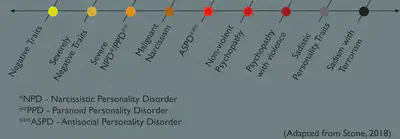50 Shades of Personality Darkness
The Dangerous Personality Types
I found something exciting when doing research on narcissism! Michael Stone - a forensic psychiatrist came up with an entire spectrum that helps us understand how narcissism and its associated traits can devolve into psychopathy and destruction.1 This spectrum has 6 main components, each one getting progressively worse.

Negative Personalities
Negative Traits
First is just all the negative personality traits that people can have, like being abrasive, argumentative, deceitful, discourteous, tactless, and unsympathetic.1 These are the annoying people who might be jerks, but aren’t necessarily dangerous or criminal. Think of the meddlesome teacher who is up in everyone’s business or the quarrelsome guy at the store who argues with the manager over an out-of-stock product.
Severely Negative Traits
The negative traits can be more severe though, like people who are aggressive, hostile, cruel, predatory, or malicious.1 It’s the people we really don’t like, or maybe even hate - they’re worse than just annoying. This might be the slanderous, vengeful ex-partner who threatens a smear campaign to end your career, or the grudge-holding boss who is still punishing the employee after a mistake that happened 2 years ago.
This is just the outer layer of the dark personality onion though. Peeling back another layer is when the negative personality traits worsen into actual personality disorders.
Severe Personality Disorders
Narcissistic Personality Disorder
In our podcast, Doc Bok and I have discussed narcissism and narcissistic personality disorder at length (blog/podcast), so I’ll briefly cover it, then provide murderous examples2 of those with narcissistic personality disorder to understand the different layers of darkness. Not everyone with narcissistic personality disorder is going to be violent, but their tendency to be self-important, entitled, exploitative, envious, and arrogant, with a need for admiration, belief they’re special, and fantasies of unlimited success do set them up for risky, yucky behaviors. If you add decreased or a lack of empathy in that mix, they are capable of violence.
- One example motivated by narcissistic greed is a guy who put pipe bombs under his mother’s car and killed her after he found out she was going to financially cut him off, AND he was hoping for a $10 million inheritance payout.2
Paranoid Personality Disorder
Not all individuals with paranoid personality disorder are going to be dangerous, but those who ARE paranoid AND commit violent crimes have the more severe criteria like pathological jealousy, grudge-holding, and vindictiveness.2 (See our blogs here and here for a better understanding of PPD). Interestingly, violent paranoids are more likely to commit mass murders (3+ kills in one outburst),2 likely because they desire to take their pain out on the world (see Personalities That Kill).
- One example was the guy who stalked then threatened to kill a coworker who would not date him, leading to him being fired. Two years later, he went back to his old workplace and killed seven people and wounded four (including the girl).2 This event was actually made into a movie in 1993 called I Can Make You Love Me.
Malignant Narcissism
Malignant narcissism is the next dark layer when personality disorders become “worse.” Malignant narcissism is narcissism with antisocial behavior (lawbreaking and against social norms), sadism/aggression (hurting others), and paranoid (attack first because everyone is out to get them) flavors.3 Check out our podcast or blog for a deeper understanding of malignant narcissism. Stone2 states, “If there is, from the standpoint of personality, one red thread running through the majority of violent crimes, this would be narcissism.” Those who choose to exploit or destroy others are obviously putting their own desires first with no consideration of others.
- An example of a violent malignant narcissist is the doctor who murdered his wife and children and unsuccessfully attempted suicide when he felt he was going to be caught…because he wasn’t actually a doctor and was faking his social status.4
Antisocial Personality Disorder
Even “worse” in the dark personalities is antisocial personality disorder. According to the DSM, antisocial personality disorder is a pattern of disregard for, and violation of, the rights of others; criminality; impulsivity; and a failure to learn from experience. It’s helpful to understand that malignant narcissists can engage in antisocial behavior, but ALL antisocial personalities include narcissism.5
- An example of someone with an antisocial personality without psychopathy is the guy who had a long childhood history of criminality, then after getting out of juvey at age 19, he became the leader of a prominent gang with a goal to protect locals from other gangs and police brutality…and during this time he was also a youth counselor. The problem was he became addicted to angel dust and killed people when stealing money to buy the drugs. He was imprisoned and sentenced to death, but later in prison, he ended up writing books discouraging black youths to engage in gangs. He was actually nominated for the Nobel Peace Prize, but was executed in 2005.6
Note here that there’s a difference between antisocial personality disorder and psychopathy. One of the biggest differences is that antisocial children don’t usually become antisocial adults, and young adults with antisocial personality disorder will “burn out” around their 40s. This aging out dynamic does not happen in psychopathy. Psychopathy is consistent and stays lifelong.6
Still curious about APD? Here are links to our blogs where you can learn more about this dangerous condition! Personalities as Ice Cream blog, Psychodynamic Personalities blog, and Personalities That Kill blog.
Psychopathy
Peeling back the next layer brings us out of personality disorders that match up with the DSM and lands us in the dark forensic psychology territory. So, what is psychopathy? Robert Hare (expert forensic psychologist) notes psychopaths are “intra-species predators who use charm, manipulation, intimidation, and violence to control others and to satisfy their own selfish needs.6” It’s also notable that psychopathy is marked by a complete absence of empathy - not just impaired empathy or blocked empathy.3 There’s actually brain imaging and studies that support this.3 Psychopaths just don’t experience emotions the same way others do.
Sociopathy/Non-Violent Psychopathy
Non-violent psychopathy is definitely a thing.
- An example of a non-violent psychopath or a sociopath is the guy who engaged in the biggest known Ponzi-scheme manipulation and swindled people out of billions of dollars. While he was non-violent with no assaults, he did not have empathy and preyed on clients.6
Violent Psychopathy
We usually think of psychopathy as involving violence. There’s a ton of examples out there, but Stone2 used this one:
- One guy was convicted of 11 murders. He has the sexually violent crime “triad” of childhood bed-wetting, animal torture, and fire-setting. Fast forward, and he ended up raping and strangling 11 prostitutes until his arrest. Stone actually interviewed him in prison and noted lack of remorse, “jollity,” pathological lying, and grandiosity. He even embellished his crimes to impress others.2
Sadism
Sadistic Personality
Peeling back the last layer of darkness in terms of personality, we find sadism. Sadistic personalities are common in those who commit violent crimes,2 and it’s notable that I’m not talking about sexual sadism here, but an actual personality style.1 Sadistic personalities achieve dominance through cruelty, humiliate others, are unusually harsh to those under them, take pleasure in others’ suffering, lie to harm others, intimidate others to get them to obey, are excessively controlling, and are fascinated by violence, weapons, martial arts, injury, or torture.1
- A watered down (It’s very sick - so look at your own risk) example of a sadistic personality is the guy who created a torture chamber and killed at least 40 women. They also found 100 videotapes of torture.2
Sadism with Terrorism
The “worst” it can get is sadism with terrorism. It’s only “worse” because it involves a very high number of hurts and deaths with the terrorism aspect, but it’s the same concept as above. An example of large scale terrorism involving sadism is Sadam Hussain, who “probably reached diagnostic threshold for the sadistic (T score M = 81.0), paranoid (T score M = 79.3), antisocial (T score M = 77.4), and narcissistic (T score M = 74.2) personality disorders7.” It’s also notable that Hussein had more sadistic features than Hitler.7
So as we funnel down the spectrum of darkness, we take all the personality stuff that precedes it. Thus, a sadistic personality is going to have it all - negative traits, narcissistic personality disorder/paranoid personality disorder, malignant narcissism, antisocial personality disorder, psychopathy, and of course, sadism. Additionally, as we funnel down the darkness spectrum, there are less and less examples of darkness, which is hopeful. On the other hand, Stone states, “There is no “worst case” of sadism, just as there is no bottom to human depravity1.” Thus, our work and understanding of humanity will never be complete.
References
-
Itzkowitz, S., & Howell, E. F. (Eds.). (2019). Psychoanalysts, psychologists and psychiatrists discuss psychopathy and human evil. Routledge. https://doi.org/10.4324/9780429262425 ↩︎ ↩︎ ↩︎ ↩︎ ↩︎ ↩︎
-
Stone, M. H. (2007). Violent crimes and their relationship to personality disorders. Personality and Mental Health, 1(2), 138–153. https://doi.org/10.1002/pmh.18 ↩︎ ↩︎ ↩︎ ↩︎ ↩︎ ↩︎ ↩︎ ↩︎ ↩︎ ↩︎
-
Wood, R. (2022). Literature review of malignant narcissism and related constructs. In R. Wood, A study of malignant narcissism: Personal and professional insights (pp. 7–41). Routledge. https://doi.org/10.4324/9781003246923 ↩︎ ↩︎ ↩︎
-
Lazaro, Y., Mesian, I., Perez, A., Madrazo, I., & Baena, R. (2016). Malignant narcissism: The notorious case of Jean-Claude Romand. European Psychiatry, 33, S630–S631. ↩︎
-
Kernberg, O. F. (1984). Severe personality disorders: Psychotherapeutic strategies. Yale University Press. ↩︎
-
Stone, M. H. (2018). The place of psychopathy along the spectrum of negative personality types. Contemporary Psychoanalysis, 54(1), 161–182. https://doi.org/10.1080/00107530.2017.1420376 ↩︎ ↩︎ ↩︎ ↩︎
-
Coolidge, F. L., & Segal, D. L. (2007). Was Saddam Hussein like Adolf Hitler? A personality disorder investigation. Military Psychology, 19(4), 289–299. https://doi.org/10.1080/08995600701548221 ↩︎ ↩︎






